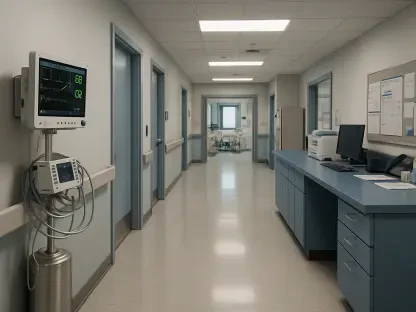Imagine a future where a simple blood test at home could predict a life-threatening condition years before symptoms appear, or where a quick diagnostic panel in a doctor’s office tailors a cancer treatment uniquely to a patient’s genetic makeup, revolutionizing personalized medicine. This vision is rapidly becoming reality as clinical laboratory tests evolve into a cornerstone of modern healthcare. With projections estimating the market to reach an impressive $225.8 billion by 2034, the landscape of diagnostic testing is undergoing a profound transformation. From routine chemistry and hematology to cutting-edge molecular diagnostics, these tests are expanding across hospitals, independent labs, and even at-home platforms, making healthcare more accessible than ever. This growth is fueled by an aging population, rising chronic diseases, and the urgent need for preventive screening and infectious disease monitoring. As technology and patient needs converge, the next decade promises to redefine how diagnoses are made and treatments are delivered.
Emerging Trends Shaping Diagnostic Testing
Technological Innovations Driving Efficiency
The pace of technological advancement in clinical lab testing is staggering, with tools like pre-analytical automation and high-throughput analyzers revolutionizing workflows. These innovations are slashing turnaround times and boosting accuracy, ensuring that patients receive results faster than ever before. Middleware integration with laboratory information systems (LIS) and electronic health records (EHRs) creates seamless data flow, allowing healthcare providers to make informed decisions in real time. Beyond hardware, artificial intelligence is emerging as a game-changer, offering quality control and decision-support tools that minimize human error. Multiplex molecular panels and companion diagnostics are also expanding test capabilities, enabling simultaneous detection of multiple conditions from a single sample. This wave of innovation isn’t just about speed; it’s about precision and reliability, ensuring that labs can handle growing demand while maintaining the highest standards of care in an increasingly complex healthcare environment.
Equally significant is the role of technology in addressing operational challenges faced by labs. With reimbursement pressures mounting and a shift toward value-based care, labs are leveraging automation to cut costs without compromising quality. AI-driven analytics help optimize resource allocation, predict equipment maintenance needs, and streamline test prioritization. Meanwhile, the integration of digital platforms fosters collaboration between labs, hospitals, and insurers, creating preferred networks that enhance efficiency. This technological backbone supports the industry’s pivot toward patient-centric models, where rapid, accurate diagnostics are no longer confined to large facilities but are accessible in smaller clinics or even at home. As these tools continue to evolve over the next decade, they will likely redefine the very structure of diagnostic services, making them more agile and responsive to both clinical and economic demands.
Shifts in Testing Accessibility and Delivery
Another transformative trend is the broadening of access to clinical lab tests through diverse delivery channels. Hospitals and independent labs remain central, but point-of-care and at-home testing options are gaining traction, driven by consumer demand for convenience. Health systems are centralizing core testing for efficiency, while rapid-response labs address urgent needs with speed. Independent lab chains are capitalizing on scale and logistics to expand their reach, often through consumer-initiated testing portals that empower patients to take charge of their health. This shift reflects a broader cultural move toward personalized healthcare, where individuals can access critical diagnostics without navigating traditional barriers. By 2034, such decentralized models could become the norm, fundamentally altering how and where patients engage with testing services.
Beyond accessibility, specific areas of testing are poised for explosive growth due to demographic and medical trends. Molecular oncology, infectious disease monitoring, women’s health, and pharmacogenomics are among the fields seeing heightened demand. These specialties address pressing global health challenges, such as rising cancer rates and the need for tailored drug therapies. Additionally, cardiometabolic risk assessments and transplant monitoring are becoming integral to preventive care, helping clinicians intervene before conditions escalate. However, this expansion is not without hurdles, as regulatory changes, pricing pressures, and supply chain resilience pose significant challenges. Despite these obstacles, the push toward high-value testing and patient-centric access models signals a future where diagnostics are not just reactive but proactive, shaping healthier outcomes across populations.
Challenges and Opportunities on the Horizon
Navigating Regulatory and Economic Pressures
As the clinical lab testing market surges forward, it faces a complex web of regulatory and economic constraints that could shape its trajectory through 2034. Governments and health authorities are tightening oversight, demanding rigorous proof of clinical utility for new tests. This scrutiny, while ensuring patient safety, often slows the pace of innovation and increases development costs for manufacturers. Simultaneously, reimbursement models are shifting, with payers emphasizing value over volume, pushing labs to consolidate testing and demonstrate tangible health outcomes. Pricing pressures further complicate the landscape, forcing providers to balance affordability with the high costs of cutting-edge technology. These dynamics create a challenging environment where only the most adaptable players are likely to thrive, highlighting the need for strategic partnerships and innovative cost-management approaches.
Compounding these issues are operational concerns that labs must address to remain competitive. Workforce shortages are a persistent problem, requiring investment in training and retention strategies to maintain service levels. Data security and interoperability also demand attention, as the integration of digital systems increases vulnerability to breaches while necessitating compliance with stringent standards. Supply chain disruptions, exposed by recent global events, underscore the importance of resilience in sourcing reagents and equipment. Despite these hurdles, opportunities abound for labs that can navigate this terrain. Forming alliances with health systems and insurers can secure market share, while demonstrating clinical value can unlock favorable reimbursement. Over the coming years, success will hinge on balancing compliance with innovation to meet both regulatory and patient expectations.
Sustainability and Strategic Growth in Focus
Sustainability is emerging as a critical priority for the clinical lab industry, reflecting broader societal shifts toward environmental responsibility. Labs are increasingly adopting energy-efficient equipment and reducing reagent waste to minimize their ecological footprint. Greener consumables are becoming a key factor in procurement decisions, aligning with global goals to curb resource depletion. This focus not only addresses ethical imperatives but also offers cost savings over time, as efficient systems lower operational expenses. By integrating sustainable practices, labs can enhance their reputation and appeal to stakeholders who prioritize corporate responsibility. This trend is expected to gain momentum through 2034, positioning sustainability as a competitive differentiator in a crowded market.
Parallel to sustainability, strategic growth opportunities are shaping the industry’s future through partnerships and specialization. Collaborations between assay developers, equipment manufacturers, and lab networks are accelerating the rollout of novel tests, particularly in high-demand areas like precision diagnostics. The competitive landscape, comprising global in-vitro diagnostic leaders and niche specialty providers, thrives on such alliances to drive innovation. Meanwhile, addressing workforce gaps through strategic planning and investing in connected workflows are vital for scaling operations. Looking back, the industry’s journey revealed a relentless drive to adapt, overcoming regulatory hurdles and economic constraints with ingenuity. Moving forward, stakeholders must prioritize sustainable practices, embrace technological integration, and forge partnerships to ensure that clinical lab tests continue to transform healthcare, delivering precise, accessible, and value-driven solutions for generations to come.









